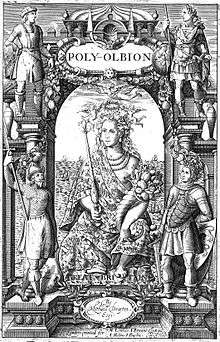Poly-Olbion
The Poly-Olbion is a topographical poem describing England and Wales. Written by Michael Drayton (1563–1631) and published in 1612, it was reprinted with a second part in 1622. Drayton had been working on the project since at least 1598.

Content
The Poly-Olbion is divided into thirty songs, written in alexandrine couplets, consisting in total of almost 15,000 lines of verse. Drayton intended to compose a further part to cover Scotland, but no part of this work is known to have survived. Each song describes between one and three counties, describing their topography, traditions and histories. Copies were illustrated with maps of each county, drawn by William Hole, whereon places were depicted anthropomorphically.
The first book was accompanied by historical and philological summaries written by John Selden.
Because of its length and its author's conflicting goals the Poly-Olbion was almost never read as a whole, but is an important source for the period nevertheless. Drayton strained to combine correct scientific information about Britain (mostly contained in Selden's commentary) with his desire to provide as many memorial anchors to the elusive ancient Celtic Britons, Druids, Bards, and King Arthur as possible.[1]
See also
Bibliography
- William H. Moore, Poly-Olbion Summary
- Oliver Elton, Michael Drayton; a Critical Study, with a Bibliography
References
- Richard Utz, "Hic iacet Arthurus? Situating the Medieval King in Renaissance Memory," Studies in Medievalism 15 (2006), 26-40; "'There Are Places We Remember': Situating the Medieval Past in Postmedieval Cultural Memories," in Transfiguration 6.2 (2004), 89-108.
External links
- Poly-Olbion in The Complete Works of Michael Drayton, vol. 3 (London, 1876)
- The Children's Poly-Olbion: A Heritage Lottery funded arts and education project introducing Drayton to children across the UK and commissioning new art work based on Poly-Olbion
- Exeter University: Poly-Olbion Project